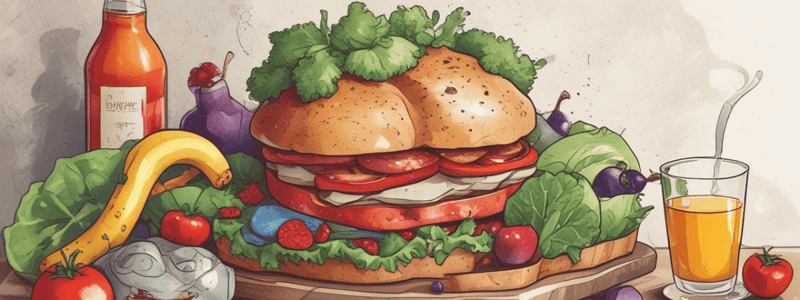Podcast
Questions and Answers
Why is it important to check the serving size on a Nutrition Facts label?
Why is it important to check the serving size on a Nutrition Facts label?
- To know the nutrient intake per serving (correct)
- To find out the price per serving
- To understand the brand's reputation
- To determine the expiry date
What does the label 'organic' mean?
What does the label 'organic' mean?
- It is produced without synthetic pesticides (correct)
- It has added genetically modified organisms
- It contains artificial preservatives
- It is enriched with vitamins
What are the benefits of preparing your own food?
What are the benefits of preparing your own food?
- It takes less time than eating out
- It is always cheaper than buying ready-made food
- You can always choose fast food
- You can control the ingredients and portion sizes (correct)
Which strategy helps prevent foodborne illnesses?
Which strategy helps prevent foodborne illnesses?
What is a benefit of using the MyPlate guide?
What is a benefit of using the MyPlate guide?
Which food safety guideline is correct?
Which food safety guideline is correct?
What does the label 'non-GMO' mean?
What does the label 'non-GMO' mean?
What is a common food additive used to improve shelf life?
What is a common food additive used to improve shelf life?
Which factor influences how healthy you eat on a daily basis?
Which factor influences how healthy you eat on a daily basis?
What is a safe practice when preparing food at home?
What is a safe practice when preparing food at home?
Flashcards are hidden until you start studying
Study Notes
Influences on Food Choices
- Food preferences are influenced by genetics, experience, emotions, and culture.
- Research has shown that genes may influence people's preferences for certain foods.
- Experience, such as comfort foods, also play a role in shaping food preferences.
- Emotions, like stress or boredom, can lead to emotional eating and unhealthy food choices.
- Cultural factors, including cultural norms and traditions, influence food preferences.
Analyzing Influences on Food Choices
- A study of college students found that 62% of female students and 29% of male students reported eating more when feeling depressed.
- Emotions can influence food choices, even when we're not aware of it.
- Advertisements, including those featuring music stars, can affect our food choices.
Understanding Nutrition Facts
- Nutrition Facts labels provide information to help us make informed food choices.
- The label includes the number of calories per serving, serving size, and daily value percentages.
- Daily Values are based on a 2,000 calorie diet, and percentages are calculated accordingly.
- Ingredients are listed in order of weight, with the most prominent ingredients at the top.
Ingredients and Food Additives
- Ingredients are listed in order of weight on food labels.
- Added sugars can be hidden in ingredients like cane syrup, molasses, and fruit juice concentrate.
- Food additives, like GRAS (generally recognized as safe), are regulated by the government.
- Food additives are used to extend shelf life, improve flavor, and enhance appearance.
Assessing Claims on Food Labels
- "Low-fat" foods must contain less than 3 grams of total fat per serving.
- "Lean" meat must contain at least 90% lean meat.
- "Heart Healthy" foods must contain at least 10% of the Daily Value for fiber and no more than 480 milligrams of sodium per serving.
- Organic foods are grown without synthetic fertilizers or pesticides, and are certified by the USDA.
- Genetically modified organisms (GMOs) use biotechnology to introduce specific traits into crops.
Preparing Nutritious Foods
- Preparing our own food allows us to control ingredients, portion sizes, and cooking methods.
- Making food at home is usually cheaper and healthier than eating out.
- Preparing food in advance can save time and promote healthy eating.
Practicing Food Safety
- Foodborne illnesses, or food poisoning, can be prevented by handling and preparing food safely.
- Foodborne infections are caused by disease-causing microorganisms.
- Food safety strategies include washing fruits and vegetables, avoiding cross-contamination, and cooking food at the appropriate temperature.
Following a Recipe
- Recipes provide step-by-step instructions for preparing a dish.
- Recipes include ingredient measurements, cooking times, and serving sizes.
- Following a recipe helps develop cooking skills and promotes healthy eating.
Enhancing Behaviors
- Choose healthy meals and snacks and make them at home.
- Consider using low-fat dairy products, granola, or other healthy ingredients.
- Measure ingredients accurately and cook at the appropriate temperature.
- Record video of yourself following a recipe and share with others.
Studying That Suits You
Use AI to generate personalized quizzes and flashcards to suit your learning preferences.




